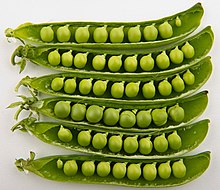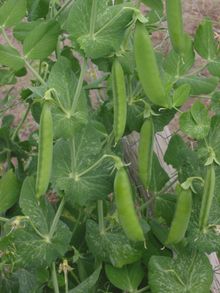
Back Ertjie Afrikaans ኣተር Amharic Pisum sativum AN بازلاء Arabic بازلاء ARZ Pisum sativum AST Əkin noxudu Azerbaijani اکین نوخودو AZB Žėrnis BAT-SMG Гарох пасяўны Byelorussian
This article needs additional citations for verification. (March 2017) |
| Pea | |
|---|---|

| |
| Peas are contained within a pod. | |

| |
| Pea plant: Lathyrus oleraceus | |
| Scientific classification | |
| Kingdom: | Plantae |
| Clade: | Tracheophytes |
| Clade: | Angiosperms |
| Clade: | Eudicots |
| Clade: | Rosids |
| Order: | Fabales |
| Family: | Fabaceae |
| Subfamily: | Faboideae |
| Genus: | Lathyrus |
| Species: | L. oleraceus
|
| Binomial name | |
| Lathyrus oleraceus | |
| Synonyms[1] | |
|
Synonymy
| |
Pea (pisum in Latin) is a pulse, vegetable or fodder crop, but the word often refers to the seed or sometimes the pod of this flowering plant species. Formerly 'Pisum sativum' (meaning cultivated pea), it has been proposed to rename the species as Lathyrus oleraceus.[2] Each pod contains several seeds (peas), which can have green or yellow cotyledons when mature. Botanically, pea pods are fruit,[3] since they contain seeds and develop from the ovary of a (pea) flower. The name is also used to describe other edible seeds from the Fabaceae such as the pigeon pea (Cajanus cajan), the cowpea (Vigna unguiculata), the seeds from several species of Lathyrus and is used as a compound form for example Sturt's desert pea.
Peas are annual plants, with a life cycle of one year. They are a cool-season crop grown in many parts of the world; planting can take place from winter to early summer depending on location. The average pea weighs between 0.1 and 0.36 gram.[4] The immature peas (and in snow peas the tender pod as well) are used as a vegetable, fresh, frozen or canned; varieties of the species typically called field peas are grown to produce dry peas like the split pea shelled from a matured pod. These are the basis of pease porridge and pea soup, staples of medieval cuisine; in Europe, consuming fresh immature green peas was an innovation of early modern cuisine.
- ^ a b Lathyrus oleraceus Lam. Plants of the World Online. Retrieved 9 August 2023.
- ^ Schaefer, Hanno; Hechenleitner, Paulina; Santos-Guerra, Arnoldo; de Sequeira, Miguel Menezes; Pennington, R Toby; Kenicer, Gregory; Carine, Mark A (2012). "Systematics, biogeography, and character evolution of the legume tribe Fabeae with special focus on the middle-Atlantic island lineages". BMC Evolutionary Biology. 12 (1): 250. Bibcode:2012BMCEE..12..250S. doi:10.1186/1471-2148-12-250. ISSN 1471-2148. PMC 3547781. PMID 23267563.
- ^ Rogers, Speed (2007). Man and the Biological World Read Books. pp. 169–170. ISBN 978-1-4067-3304-4. Retrieved on 2009-04-15.
- ^ "Pea". Purdue.edu. Retrieved 21 August 2017.
© MMXXIII Rich X Search. We shall prevail. All rights reserved. Rich X Search